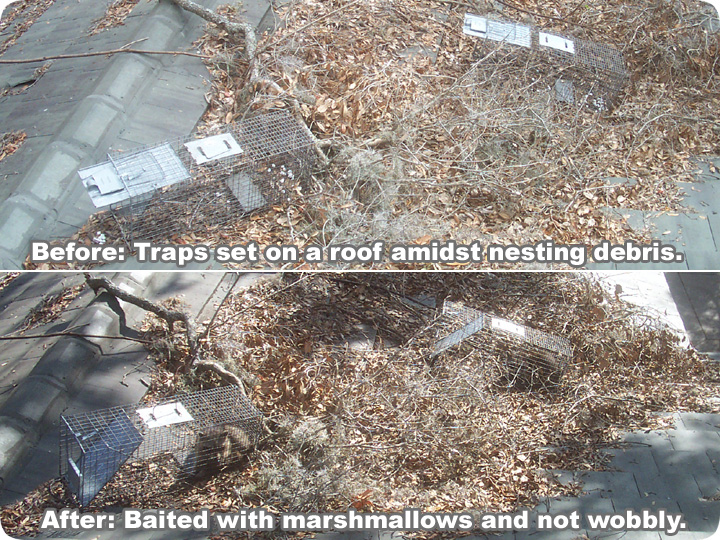
Click the buttons to the left or right for more examples of how the pros set traps in different situations.
In the above photos, you can see a case of debris on a flat tile roof. A nearby tree dropped twigs and leaves on the roof and made a nice nesting area for a family of raccoons. I set several traps in different areas of the roof and caught four raccoons, two pictured here.
If you need professional help, click my Hire A Pro page. I've compiled the USA's best directory of raccoon removal experts.
Raccoons on roof - There are times when you cannot get to the raccoon inside of your home. Not all raccoons in a roof are accessible through the attic or the crawl space. For these animals, your best bet is to attach a cage trap to the roof itself. Remember to put down some trap backing beneath the cage or any captured raccoons will destroy your shingles trying to get out. The trap should be near the opening and baited with marshmallows or bread—something that won’t draw in carrion eaters. The last thing you want is for your raccoon problem to turn into a rat problem. If you don’t want to place the trap on your roof, you can set it on the ground near the area where the raccoon is scaling the house or a nearby tree. This might take some time to figure out; look for droppings or other signs the raccoon has been near the building. Make sure the trap is on a level surface and is not near any debris. A raccoon will not go near something that seems suspicious; they are far too smart. Once the adult has been captured, or during the process, look for any young. Most raccoons inside of a home are females. If you catch an adult, look for protruding nipples that would indicate it has been nursing a litter.
Click below photos for more examples of trap sets by professionals:
This is a series of photos of trap sets in the field. These examples are meant to show how professional trap setting looks. The reality is that every case of raccoon trapping is different: number of raccoons, location, type of architecture of the roof or attic they are in, etc. I've done over 1000 raccoon trapping jobs, and every set has been different. There are so many little variables that mean the difference between success and big problems! Trapping is not for amateurs.
If you need professional help, click my Hire A Pro page. I've compiled the USA's best directory of raccoon removal experts.
Raccoons on roof - There are times when you cannot get to the raccoon inside of your home. Not all raccoons in a roof are accessible through the attic or the crawl space. For these animals, your best bet is to attach a cage trap to the roof itself. Remember to put down some trap backing beneath the cage or any captured raccoons will destroy your shingles trying to get out. The trap should be near the opening and baited with marshmallows or bread—something that won’t draw in carrion eaters. The last thing you want is for your raccoon problem to turn into a rat problem. If you don’t want to place the trap on your roof, you can set it on the ground near the area where the raccoon is scaling the house or a nearby tree. This might take some time to figure out; look for droppings or other signs the raccoon has been near the building. Make sure the trap is on a level surface and is not near any debris. A raccoon will not go near something that seems suspicious; they are far too smart. Once the adult has been captured, or during the process, look for any young. Most raccoons inside of a home are females. If you catch an adult, look for protruding nipples that would indicate it has been nursing a litter.
Click below photos for more examples of trap sets by professionals:
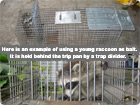 |
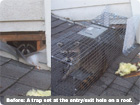 |
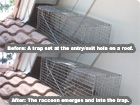 |
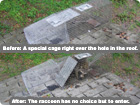 |
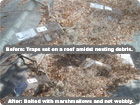 |
This is a series of photos of trap sets in the field. These examples are meant to show how professional trap setting looks. The reality is that every case of raccoon trapping is different: number of raccoons, location, type of architecture of the roof or attic they are in, etc. I've done over 1000 raccoon trapping jobs, and every set has been different. There are so many little variables that mean the difference between success and big problems! Trapping is not for amateurs.

